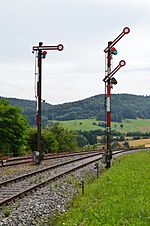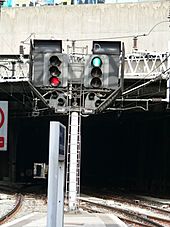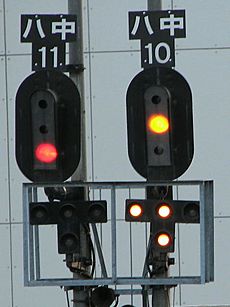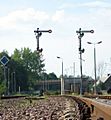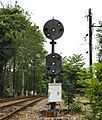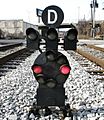Railway signal facts for kids
A railway signal is a visual display device that conveys instructions or provides advance warning of instructions regarding the driver’s authority to proceed. The driver interprets the signal's indication and acts accordingly. Typically, a signal might inform the driver of the speed at which the train may safely proceed or it may instruct the driver to stop.
Application and positioning of signals
Originally, signals displayed simple stop or proceed indications. As traffic density increased, this proved to be too limiting and refinements were added. One such refinement was the addition of distant signals on the approach to stop signals. The distant signal gave the driver warning that he was approaching a signal which might require a stop. This allowed for an overall increase in speed, since train drivers no longer had to drive at a speed within sighting distance of the stop signal.
Under timetable and train order operation, the signals did not directly convey orders to the train crew. Instead, they directed the crew to pick up orders, possibly stopping to do so if the order warranted it.
Signals are used to indicate one or more of the following:
- That the line ahead is clear (free of any obstruction) or blocked
- That the driver has permission to proceed
- That points (also called switch or turnout in the US) are set correctly
- Which way points are set
- The speed the train may travel
- The state of the next signal
- That the train orders are to be picked up by the crew
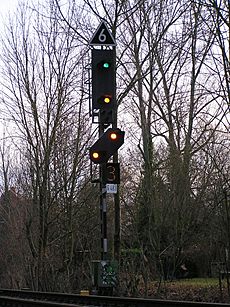
Signals can be placed:
- At the start of a section of track
- On the approach to a movable item of infrastructure, such as points or switches or a swingbridge
- In advance of other signals
- On the approach to a level crossing
- At a switch or turnout
- Ahead of platforms or other places that trains are likely to be stopped
- At train order stations
'Running lines' are usually continuously signalled. Each line of a double track railway is normally signalled in one direction only, with all signals facing the same direction on either line. Where bidirectional signalling is installed, signals face in both directions on both tracks (sometimes known as 'reversible working' where lines are not normally used for bidirectional working). Signals are generally not provided for controlling movements within sidings or yard areas.
Images for kids
-
Mechanical semaphore signals at Kościerzyna in Poland
-
Network Rail (UK) two-aspect colour light railway signal set at 'danger'
-
Railway signal in Ploiești West railway station, Romania. This type of signal is based on the German Ks signals.
-
Dwarf signal at Utrecht Centraal, Netherlands
See also
 In Spanish: Señalización ferroviaria para niños
In Spanish: Señalización ferroviaria para niños


